The Role of Gestures in Iraqi Influencers' Digital Communication
دور الإيماءات في التواصل الرقمي للمؤثرين العراقيين
Tabark Wafaa Ali1, Amal Khudair Henedy2, Asst. Lect. Tahir Mohammed Tahir3
1Al-Muthanna University, Faculty of Education for Human Sciences, Department of English E-mail: eduetabarkwafa@mu.edu.iq
2Al-Muthanna University, Faculty of Education for Human Sciences, Department of English E-mail:amalkhudair6@gmail.com
3Asst.Lec. Al-Muthanna University, Faculty of Education for Human Sciences,Department of English. Research Supervisor. E-mail:Tahirmtahir@mu.edu.iq
DOI: https://doi.org/10.53796/hnsj64/2
Arabic Scientific Research Identifier: https://arsri.org/10000/64/2
Volume (6) Issue (4). Pages: 22 - 34
Received at: 2025-03-07 | Accepted at: 2025-03-15 | Published at: 2025-04-01
Abstract: Gestures are instinctive and common in daily life, conveying information about culture, emotions, thoughts, and intentions. They serve as a non-verbal form of communication, using movements of the hands, face, and body to express feelings and ideas, often complementing spoken language. While speech and gestures can function independently, they typically work together to enhance understanding and confidence in conversations. This study seeks to examine the use of gestures by Iraqi influencers, with a particular focus on Muna Sami, who is one of the prominent media figure in Iraqi social media. This study will explain what gestures are, talk about different types of gestures, and examine their influence on the communication of Iraqi social media influencers. The analysis is grounded in McNeill's theory of gestures, which categorizes gestures into five distinct types. McNeill argues that gestures play a crucial role in speech, as they assist in the thinking process. In his model, he describes how gestures and speech interact to facilitate communication. This integration of gestures and verbal expression enables individuals to articulate their thoughts more effortlessly. This theoretical framework is applied to examine Muna Sami's gestures during one of her program episodes. By examining the various types of gestures employed by Sami, this study shows how these non-verbal cues contribute to overall communication strategy. The findings suggest that Iraqi influencers, strategically utilize gestures to enhance their engagement with audiences, thereby improving the clarity and effectiveness of their messages. Ultimately, this study contributes to a deeper understanding of how gestures function as a vital component of communication among influencers in the digital age.
Keywords: gestures, influencers, communication.
المستخلص: تعتبر الإيماءات غريزية وشائعة في الحياة اليومية، حيث تنقل معلومات حول الثقافة والعواطف والأفكار والنوايا. وهي بمثابة شكل غير لفظي من أشكال الاتصال، باستخدام حركات اليدين والوجه والجسم للتعبير عن المشاعر والأفكار، وغالبًا ما تكمل اللغة المنطوقة. وبينما يمكن للكلام والإيماءات أن تعمل بشكل مستقل، إلا أنها تعمل عادةً مع الكلام لتعزيز الفهم ونقل الثقة في المحادثات. يسعى هذا البحث إلى دراسة استخدام الإيماءات من قبل المؤثرين العراقيين، مع التركيز بشكل خاص على منى سامي، وهي واحدة من الشخصيات الإعلامية البارزة في وسائل التواصل الاجتماعي العراقية. تعرض الباحثون في هذه الدراسة الى بيان ماهية الإيماءات، وماهي أنواع الإيماءات، ومدى تأثيرها على تواصل المؤثرين العراقيين على وسائل التواصل الاجتماعي. ويستند التحليل إلى نظرية ماكنيل للإيماءات، التي تصنف الإيماءات إلى خمسة أنواع مميزة. يزعم ماكنيل أن الإيماءات تلعب دورًا مهماً في الكلام، حيث تساعد في عملية التفكير. في نموذجه، يصف ماكنيل كيف تتفاعل الإيماءات مع الكلام لتسهيل التواصل. إن هذا التكامل بين الإيماءات والتعبير اللفظي يمكّن الأفراد من التعبير عن أفكارهم بسهولة أكبر. تسعى هذه الدراسة الى فحص إيماءات منى سامي خلال إحدى حلقات برنامجها. من خلال فحص الأنواع المختلفة من الإيماءات التي تستخدمها منى سامي، تُظهر هذه الدراسة كيف تساهم هذه الإشارات غير اللفظية في استراتيجية الاتصال الشاملة. حيث تشير النتائج إلى أن المؤثرين العراقيين يستخدمون الإيماءات بشكل استراتيجي لتعزيز تفاعلهم مع الجماهير، وبالتالي تحسين وضوح وفعالية رسائلهم. في النهاية، تساهم هذه الدراسة في فهم أعمق لكيفية عمل الإيماءات كمكون حيوي للتواصل بين المؤثرين في العصر الرقمي.
الكلمات المفتاحية: الإيماءات، المؤثرين العراقيين، التواصل.
1. Introduction
Gestures are common and instinctive in people’s daily lives, providing details about culture, conversation, feelings, thoughts, intentions, emotions, understanding others, thinking, and learning different languages. Gestures are a way of communicating without using words or sounds, where movements and visual cues convey certain messages, either on their own or alongside speaking. Gestures are movements made by hands, face, or other body parts. They help people express different feelings and thoughts, like dislike or love, and are often used with body language and words during conversations. Typically, speech and gestures usually work separately, but they are used together to give confidence and understanding (Haviland, 2004).
Social media influencers are a type of digital content creators known for their large online following, unique brand identity, and relationships with sponsors. They are recognized for their distinct brand and collaborate with sponsors.They make money by promoting products and services to their followers through informative, advice-filled, and inspiring posts. Influencers can vary greatly in their communities and practices on different platforms. Some influencers also challenge the term influencer because it focuses heavily on marketing and consumer influence. Most influencers start by building their brand on a specific social media platform like Instagram or YouTube before expanding to other sites (Duffy, 2020).
This study will explain what gestures are, talk about different types of gestures, and examine their influence on the communication of Iraqi social media influencers. Furthermore, a video analysis will be employed to evaluate the impact of gestures on the communication style of influencers. The results will emphasize the importance of gestures in effectively conveying messages.
In addition, this study will focus on Albert Mehrabian’s theory, which shows how important nonverbal communication is for showing emotions and attitudes. It is especially important when verbal and nonverbal signals don’t match. Knowing about this theory can help improve how people communicate in different situations (EKman & Friesen, 2003).
2. Literature Review
Speaker gestures are closely related to speech and have various pragmatic purposes to support verbal communication. As a result, gestures are an integral component of language.This review of literature analyzes a number of past research studies that have investigated the role of gestures in various domains.
In his study, Goldin-Meadow (2015) examines the use of gestures for linguistic analysis. At the outset, he defined gesture as visible action when it is used as an utterance or as part of an utterance. These visible actions encompass a variety of behaviors, such as pointing, shrugging, nodding, illustrating, the size, shape, and position of things show how to do tasks, represent abstract concepts and connections, and express other common ways people communicate using their bodies. The researcher suggests that gestures are important for communication and can help to understand how people think and improve comprehension. This research shows that studying gestures can help to learn more about the mental processes that affect how people develop and use language.
Similarly, Trotta& Tonelli (2017) investigate in their study of gestures in interviews, the hand movements and gestures made by various Italian politicians while talking in person during interviews. Their research explores the importance of gestures in interviews, examining how they influence communication, convey confidence, and impact the overall impression made on interviewers, as gestures serve as a powerful complement to spoken language. They can clarify, emphasize, or contradict verbal messages. For instance, they show that when a candidate expresses enthusiasm about a role while simultaneously using open hand gestures, it reinforces their excitement. Conversely, crossed arms or closed-off body language can signal defensiveness or discomfort, potentially undermining the verbal message of eagerness. In addition they confirm that effective gestures can enhance understanding and engagement, making the conversation more dynamic and relatable. Moreover, gestures can help convey complex ideas succinctly. A candidate discussing a project might use hand movements to illustrate timelines or processes, making it easier for the interviewer to visualize their contributions. This visual aid not only enhances clarity but also demonstrates the candidate’s ability to communicate effectively.
Chare& Watkins (2017) discusse the analysis of gestures in films describing gestures are seen as a way of expressing emotions through physical actions and movements, in which they are displayed through body language, facial expressions, and hand movements, that actors utilize to depict a character’s emotions. As the researchers clarify, that gestures in films play a crucial role in developing characters by providing viewers with a deeper understanding of their personality, intentions, and feelings. they discusse in thier research a set of TV films such as the Swedish TV show Real Humans, directed by Harald Hamrell and Levan Akin from 2012 to 2013, and the UK film The Remains of the Day, directed by James Ivory in 1993. Chare and Watkins’s analysis shows that gestures are essential tools for conveying a character’s emotion and intention, influencing the audience’s perception and interpretation. they analyzes conclude that gestures are essential for a nuanced understanding of cinematic storytelling, emphasizing the need for filmmakers to consciously integrate them into their work for greater impact.
Moreover, Kelmaganbetova (2023) study gestures in communication. At first, they explain that gestures are actions used to communicate using fingers, hands, and arms, as well as body movements and facial expressions. As well as they mention that the gestures are classified into different types, including beats, iconic, metaphorical, and deictic gestures. They state that the researchers have identified two main types of gestures : those that go along with speech and symbolic gestures or emblems. These gestures include illustrator gestures, emblem gestures, regulators, affective displays, and adapters. their studies show that gestures in communication are used to express and show a person’s thoughts and emotions. These studies concludes that gestures play a big role in communication and deserve special attention, and the main purpose of a gesture in communication is to show and express a person’s thoughts and feelings.
3. Pragmatic Inferences
Pragmatics is a part of linguistics that looks at how the situation affects the meaning of words. It is different from semantics, which is all about the exact meaning of words and sentences. Pragmatics studies how language is used in everyday life, considering things like what the speaker wants, their relationship with the listener, and the culture they’re in. For example, the meaning of something someone says can totally change depending on who is talking, where they are, and what both people already know. This part of language shows how important it is to consider the situation when trying to understand communication. It reminds that meaning doesn’t only come from words but also from the context in which they are used (Ariel, 2010).
In pragmatics, implicature refers to the implied meaning or suggestion that a speaker conveys indirectly rather than stating it explicitly. It involves understanding what is meant beyond the literal words spoken, often relying on context, shared knowledge, and social cues. For instance, when someone says, It is getting cold in here, they might be hinting that they want a window closed or the heat turned up, even though they didn’t ask for it directly. This shows how pragmatics helps in communication by relying on context and shared understanding. Scholars such as H.P. Grice have played a big role in this area by coming up with conversational rules that help to understand how people usually understand conversations. In general, pragmatics helps to learn more about language by showing how complicated human interaction can be (Levinson, 1983).
Furthermore, according to Betti (2021), pragmatics explores the influence of context on interpretation. Pragmatics covers topics such as implicature, speech acts, relevance, and discourse. Pragmatic theories are closely related to semantic theories, which focus on meaning that is encoded through grammar or vocabulary. Pragmatic competence refers to the skill of comprehending the intended meaning of a speaker.
Pragmatic inference is when people figure out the meaning behind what someone is saying by looking at the situation and what the speaker really means, not just the words they say. It is about understanding the hidden meanings, intentions, and assumptions that aren’t directly said. This kind of inference helps people communicate better by picking up on the subtle hints and social cues in conversations. When someone asks for salt at the dinner table, they might actually be asking for help, not just salt. This shows how understanding the hidden meaning behind words is important in daily conversations (Yule, 1996).
Pragmatic inference is also influenced by cultural and social contexts, as different cultures may have distinct norms regarding communication styles and expectations. For instance, in certain cultures, indirectness is valued, and speakers may rely heavily on pragmatic inference to convey their messages subtly. This can lead to challenges in cross-cultural communication, where assumptions about directness or politeness may differ significantly. As such, recognizing the role of pragmatic inference in language use can enhance intercultural understanding and improve communication strategies across diverse settings. Students continue to explore these dynamics, emphasizing the importance of context in shaping meaning and interpretation in human interactions (Loukusa & Moilanen, 2009).
Understanding pragmatic inference is important for human communication because it involves more than just the words that used. By looking at the situation, what the speaker wants, implied meanings, and assumptions, people can better understand each other and improve their language skills. Exploring pragmatic inference in different areas like education, artificial intelligence, and literature helps to learn more about how humans communicate (Clark & Murphy, 1982).
4. Political Discourse Analysis
Political discourse analysis looks at how language is used in politics, whether spoken or written, to create and maintain power, share ideas, and shape how people think. It shows that language does not only reflect what is happening in politics; it also helps to create social identities, norms, and values.This type of analysis stresses the importance of context, meaning it should look at both the specific words used and the larger social and political situations surrounding the conversation. By studying patterns in political speeches, news articles, and other forms of communication, this analysis aims to reveal how language can persuade, manipulate, or support and challenge those in power. Using ideas from linguistics, sociology, and cognitive science, it provides a deeper understanding of how political communication works (Van Dijk, 1997).
Political discourse analysis is important for understanding how language and power interact in politics. It shows that political language is not just a mirror of events but also a powerful tool that shapes how people see the world. By looking at what politicians, the media, and others say, it can be seen how their words can sway public opinion, gather support, or spark opposition. This analysis highlights the need to consider the context, as understanding political language often relies on cultural, historical, and situational factors that affect both what the speaker means and how the audience interprets it. Taking a critical look at political discourse analysis brings attention to the ethical issues surrounding political language and how it can either support or challenge existing power structures. Researchers should be mindful of their own views and biases when studying political language, as these can greatly influence their findings. By using methods from linguistics, sociology, and political science together, it can gains a clearer picture of how language works in political systems, helping to understand the deeper ideas that drive political communication and its effects on democracy (Dunmire, 2012).
5. Language, Gesture and Thought
Language plays a crucial role in human interaction, playing a vital role in molding Peoples’ ideas, traditions, and communities. It acts as the main tool for conveying thoughts, feelings, and convictions through spoken and written forms, as well as sign and body languages. This wide range of linguistic expressions mirrors the richness of human existence, with each language having its unique structures, lexicons, and subtleties that shape individuals’ perceptions of reality (Yule, 2022).
The progression of language is an intriguing voyage that reflects the growth of human society, evolving through social interactions, technological progress, and cultural interchange. Language is intricately connected to the cognition and self-concept, with studies indicating that human’s language choices can impact their cognitive patterns and affect how people interpret events and understand the world around .The evolution of language is a fascinating area of study that reveals how languages develop, change, and sometimes die out over time (Crystal, 2000).
Gestures are a powerful form of non-verbal communication that convey emotions, intentions, and meanings without words, such as hand signals, facial expressions, and body postures. They enhance verbal interactions, adding emphasis and engagement, like a thumbs-up for approval or a wave for greeting. However, cultural differences can greatly affect gesture interpretation, making it crucial to be culturally aware, as a gesture perceived as friendly in one culture can be offensive in another. In education, gestures improve students’ understanding and retention by fostering interactive learning environments. Overall, gestures play a key role in expressing meaning and enhancing human relationships (Capone & McGregor, 2004).
Gestures have been classified into different types, such as iconic gestures, which represent what someone is talking about; deictic gestures, which point to specific objects or places; and beat gestures, which emphasize the rhythm of speech. This method of communication highlights the importance of gestures in conveying details that words alone might miss (Goldin-Meadow, 1999).
Thought is a complicated process in people minds that helps them understand, think about, and react to what is happening in their environment. It involves many mental tasks like figuring things out, solving problems, and making choices. Basically, thought help to create ideas, connect thoughts together, and think about things in a deeper way. Sharing thoughts with others is essential for personal growth and learning. It also helps in communicating and interacting with people. When people share their ideas, they can work together, make deals, and form connections, which helps to understand themselves and how to fit into the world (Baum, 2004).
Additionally, thoughts are shaped by things like culture, surroundings, and Peoples’ own experiences. Various schools of thought have looked into how thinking affects how people think and act. Cognitive psychology studies how people process thoughts, while existential philosophy questions the reasons behind their thoughts. As technology and lots of information influence them, their thinking is always changing. This makes people think about how important it is to think critically and be mindful, as they deal with more and more ideas and information. It’s important to pay attention to how human beings think in order to grow in individuals and move society forward (Whorf, 2012).
6. McNeill’s Growth Point Model
McNeill (2005) believes that gestures are really important when someone is speaking because they help with the thinking process. In his model he talks about how gestures and speech work together to help people think and talk. This combination of gestures and speech helps people form their thoughts into words more easily. Gestures are more than just symbols. They actually help to shape thoughts by showing ideas in a tangible way. Like words, gestures can express and form Peoples’ thoughts. When gestures and speech work together, they create a common understanding, making the messages clearer. McNeill believes gestures are like ‘material carriers’ that hold meaning and help language become more powerful, making communication more engaging. The growth point is an important part of how people use images and language together when they talk. It shows the first step of thinking while speaking, mixing words and pictures to show how speech and gestures work together. The growth point shows when an idea starts to form clearly, giving a hint of what will come next in the conversation.
The Growth Point, serving as a model for dialectical processes, represents the smallest dynamic unit within the imagery language dialectic a combination of visual imagery and linguistic categories that drives thought and communication. It encapsulates both linguistic and imagistic elements as equal components rather than alternatives. Essentially, the imagery language unit can be observed in coordinated combinations of expressive speech and gestures. This is termed a growth point because it signifies the foundational stage of thought during speech, from which an organized dynamic process develops. It also highlights there is a specific starting point for cohesive thoughts. The growth point emerges as an idea unit from its prior context and influences subsequent speech. At this moment, gesture and speech are synchronized at the psychological level. Recognizing that context is essential for the growth point to function as a psychological predicate, the Growth Point model views context as a vital aspect of thinking while speaking, rather than just an external factor (McNeill, 2005).
In addition, McNiell builds on Heidegger’s idea that gestures serve as a physical means of conveying meaning. McNiell (2005) states that “by performing the gesture, a core idea is brought into concrete existence and becomes part of the speaker’s own existence at that moment” (p.99). A gesture is not just a simple representation, it is a way of being. Just like words, gestures can be seen as a form of thinking, they express thoughts and represent thought itself. Therefore, making a gesture brings ideas into the real world, similar to how writing a word does the same thing. Both gestures and speech allow people to exist cognitively in the moment they are speaking, they are not just ways to send messages or communicate. In which, Words and images work together to create shared experiences of understanding. They are connected and together create a space for people to engage in. So meaning emerges from the interaction between gestures and language, as gestures interact with the symbols of language, forming a deeper context for communication.
McNeill’s Growth Point Model examines how gestures are classified within the semiotic system of signs, according to him, there are five main types of gestures:
1. Iconic gestures are visual representations of concrete ideas or actions that closely mirror spoken content, serving as representational gestures.
2. Metaphoric gestures, on the other hand, convey abstract concepts through metaphorical forms or spatial representations, enabling the communication of ideas that go beyond literal meanings.
3. Deictic gestures are used to point to objects, places, or ideas to help clarify references during discussions, often with an extended finger for emphasis.
4.Beats are fast, rhythmic hand or finger movements that go along with speech, highlighting important points or showing shifts without being directly related to the words being spoken. They are used to emphasize key moments in communication.
5.Interactive gestures were first introduced by Bavelas et al. to help conversations flow smoothly by facilitating turn-taking between speakers and listeners.
7. Iraqi Influencers’ Digital Communication
Muna Sami has established herself as a prominent figure in the realm of political media in Iraq, hosting numerous political programs across various Iraqi television channels. Her programs address critical issues facing Iraq and the broader Arab world, facilitating discussions that engage a diverse array of influential personalities, including politicians, activists and scholars. Through her adept moderation and distinctive conversational style, Sami has garnered recognition for her ability to navigate complex topics with clarity and insight. She skillfully manages dialogues, fostering an environment where nuanced perspectives can be explored and debated. This capability not only enhances the quality of discourse but also encourages viewers to engage critically with the issues presented. Sami’s emergence as a leading media personality extends beyond her television appearances; she has become a significant voice in advocating for social and political change. Muna’s platforms often highlight pressing matters such as governance, human rights, and women’s empowerment, contributing to a broader dialogue on these essential topics within Iraqi society and the Arab region.Furthermore, her commitment to promoting informed discussion has positioned her as a key player in shaping public opinion and fostering civic engagement. By addressing the challenges and opportunities facing her country and the Arab world, Muna Sami continues to influence the media landscape, empowering audiences to participate actively in the democratic process and advocate for meaningful reform (Slim, 2024).
8. Process
This study aims to provide a comprehensive understanding of gestures, their various types, and their impact on the communication strategies employed by influencers in relation to their audiences. It explores how gestures can imbue spoken language with greater significance and thereby enhance the messages conveyed to listeners. The scope of this study has been expanded to examine five specific types of gestures: beats, iconic, metaphoric, deictic, and interactive. The focus will be on the communication practices of Iraqi influencers, with Muna Sami serving as a primary example for analyzing the body language and gestures she employs to convey ideas to her viewers. Additionally, the study will investigate how these gestures facilitate interactions between Sami, her audience, and her guests . It will analyze the gestures employed by Muna Sami during her interview with three prominent political figures,and they are: political researcher Essam Hussein, political writer Sami Al-Murshid, and Fadi Bodie, the editor-in-chief of the Mazaya International Network. The analyses focus on an episode of her program ‘From the Fourth Side with Muna Sami’ titled ‘Riyadh Summit: A Call for Unity to Stop the Aggression Against Lebanon and Gaza’. This show was televised on November 11, 2024. The duration of the episode was 54 minutes and 21 seconds on the ‘ AlRabea channel’. This episode was recorded after the summit held in Saudi Arabia.
The study will meticulously examine various aspects of Muna Sami’s communication, with particular emphasis on her facial expressions, body language, and hand gestures. The analyses will categorize the gestures utilized by Muna Sami, distinguishing between supportive gestures that enhance her message by demonstrating commitment and emotional gestures that convey insistence, discontent or shock. Furthermore, the investigation will explore how these gestures influence the overall messaging throughout the episode, shaping audience perception and engagement.
9. Data Analysis
First instance: ‘A final call’ ‘نداء اخير’
This episode which is titled ‘Riyadh Summit: A Call for Unity to Stop the Aggression Against Lebanon and Gaza’, broadcasted on the Alrabea channel by Muna Sami, it will observe a compelling presentation that begins on November 11. Notably, in the opening moments, Muna Sami employs a variety of gestures to convey different messages.
Muna begins her episode with a succinct introduction that outlines the central theme namely the ‘Riyadh Summit’ This summit, held in Saudi Arabia, aims to explore measures and solutions to halt Israel’s military actions against Gaza and Lebanon. During her discussion of the Riyadh Summit, it was observed that she employs a variety of hand gestures to enhance her communication. Notably, she utilizs her right hand, clenching her fingers as she articulated key points. Specifically, when she mentions the phrase “An extraordinary Arab summit is like a final call to restore the rest of the dignity of this nation” (Sami, 2024, 0:17). she raises her hand in an up-and-down motion, which serves to underscore the significance of this statement. Additionally, she places particular emphasis on this phrase through vocal modulation and facial expressions, including the movement of her lips. This combination of gestural and vocal emphasis not only drews attention to her message but also reinforces its importance within the context of her overall narrative. Such nonverbal communication techniques are critical in effectively conveying meaning and engaging an audience.
In this instance, Muna employs a particular category of gesture referred to as ‘beats’, which represents a form of non-verbal communication that serves to augment spoken language. These rapid hand movements are deliberately utilizes to emphasize specific elements of her discourse, thereby amplifying the overall impact of her message. This approach facilitates a transition in the narrative from a mere recounting of events to offering a more nuanced commentary on their significance.
In her use of both vocal emphasis and gestural expression, particularly when articulating ‘A final call’ (نداء اخير), Muna seeks to draw the audience’s attention to this critical topic. Her gestures serve not only to engage viewers but also to evoke a sense of urgency regarding the situation in Gaza and Lebanon. By employing this strategy, she underscores the importance of the Riyadh Summit as potentially the last opportunity to restore peace in these regions.
Through these gestures Muna aims to highlight that this summit represents not just another diplomatic meeting, but rather a crucial juncture for the stability of Lebanon and Gaza. The phrase ‘A final call’ encapsulates her message that time is running out for meaningful intervention and resolution. Through her effective use of gestures and vocal emphasis, Mona Sami successfully communicates the gravity of the situation, urging her audience to recognize the importance of this moment in history.

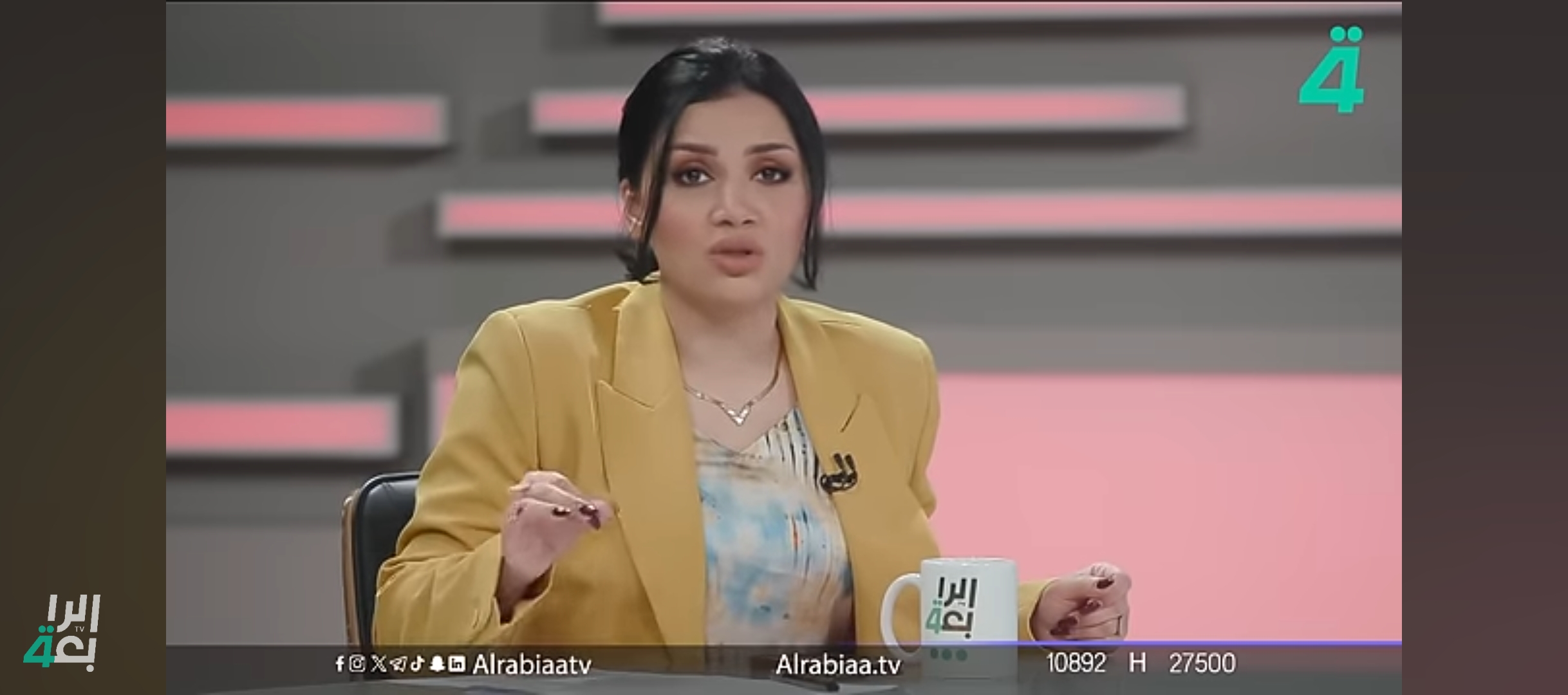
Second instance: ‘The war between Lebanon and Gaza.’الحرب بين لبنان وغز’
In the introduction of Muna’s program, Muna addresses the phrase “Calls for unity and taking a firm stance against the military escalation and the destruction left by the war between Lebanon and Gaza” (Sami, 2024, 0:30). It was observed that Muna employes both hands when referencing Lebanon and Gaza. Specifically, she gestures by opening her hands and moving them up and down, using one hand to signify Lebanon and the other to represent Gaza. This deliberate use of gesture suggests that she aims to highlight a shared aspect or commonality between the two regions concerning a particular issue.
This statement exemplifies a second type of gesture known as ‘Metaphoric gestures’, which are a significant aspect of non-verbal communication. ‘Metaphoric gestures’ play a crucial role in conveying ideas to viewers, as they provide clarity and detail through the embodiment of concepts using hand movements.
By employing this type of geasture, Muna not only emphasizes her points but also visually reinforces the connection she perceives between Lebanon and Gaza, thereby enhancing the audience’s understanding of the complexities involved in the discussion. Such gestures serve as a powerful tool in non-verbal communication, allowing speakers to convey nuanced meanings and foster a deeper engagement with their audience.
In this instance Muna Sami aims to emphasize that both Gaza and Lebanon hold equal significance, particularly in light of their shared adversary. She underscores that both regions do not deserve the extensive destruction they have endured. Furthermore, her gestures serve to question the decision-making processes that have led to the ongoing devastation in these areas. By embodying these concepts through her movements, Sami not only communicates her message more effectively but also invites viewers to reflect on the broader implications of conflict and destruction in the region.
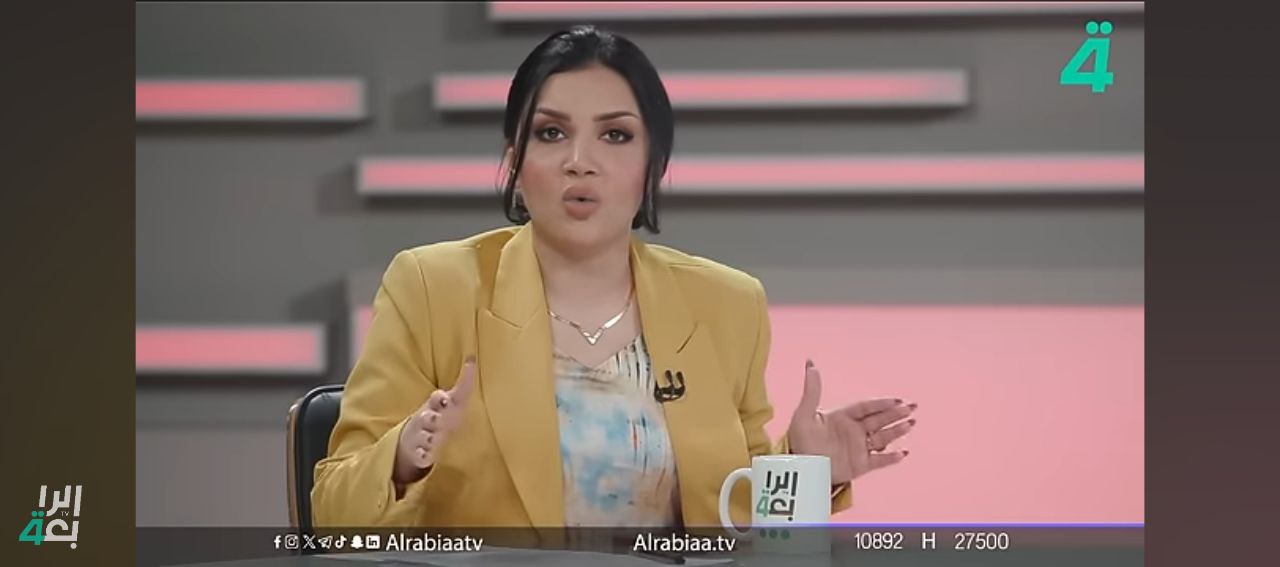
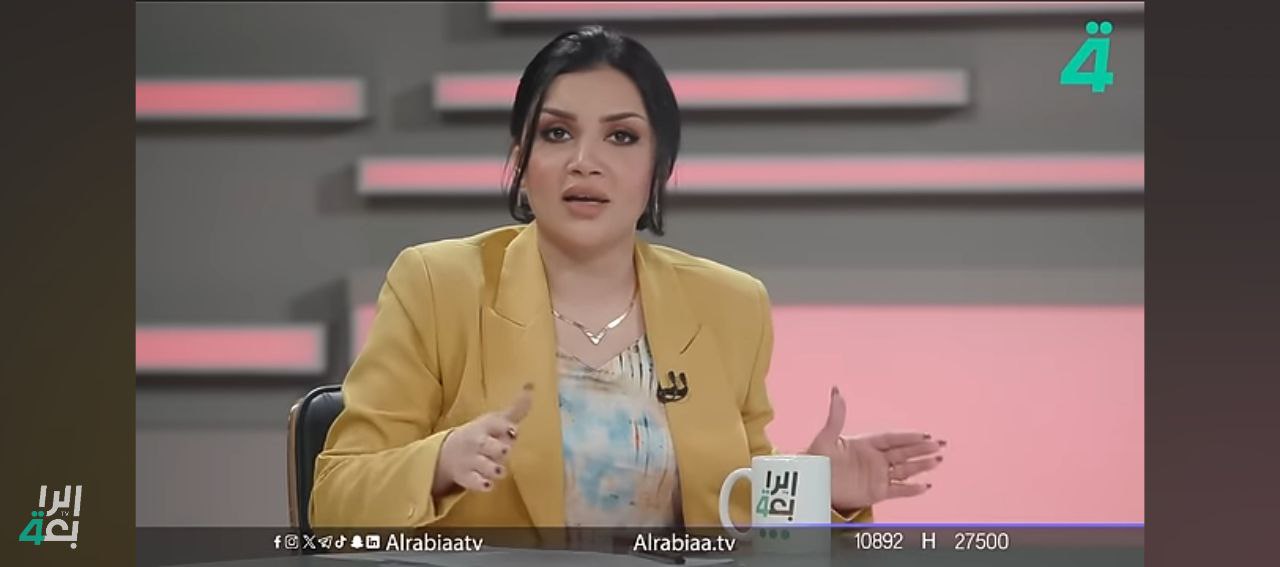
Third instance: ‘ Shiaas_Sunni War’ ‘الحرب شيعية سنية’
In another instance of the episode, Muna’s hand movements clearly demonstrats her deep engagement in the discussion, particularly evident from her raised voice, lifted hand, and extended index finger directed toward the guest, Essam Hussein, who was seated directly in front of her. This signaling is further emphasized by her wide-open eyes, indicating surprise, as she echoes the guest’s question. This moment confirmes her intense focus on Essam. Her gestures indicate that she utilizes a specific type of non-verbal communication known as ‘ deictic gestures’
Deictic gestures are used to indicate a specific object or concept and to pinpoint its location within the conversation. These gestures are highly contextual and often involve the use of hands or fingers to point to people, objects, or ideas. Muna utilizes this type of gesture when she was taken aback by Essam’s statement regarding that it is a war to end Shiaas power in the region by Sunni Muslim countries. Responding to this bold remark, she expresses her astonishment by asking, “Shiaas! It is Shiaas-Sunni war?” (Sami, 2024, 34:43). Her deictic gesture toward him drows the attention of both the guests and the viewers to this significant assertion. This strategic use of deictic gestures allowes her to emphasize the importance of the guest’s statement, encouraging viewers to reflect on the bold implications of his claim by reiterating his words to affirm their accuracy and raise the significance of the topic.
Muna’s skillful use of these gestures not only captures the attention of all participants in the dialogue but also highlights the seriousness of the discussion. Her nonverbal communication strategy enhances the significance of the statements made and facilitated a richer conversation among the present guests.
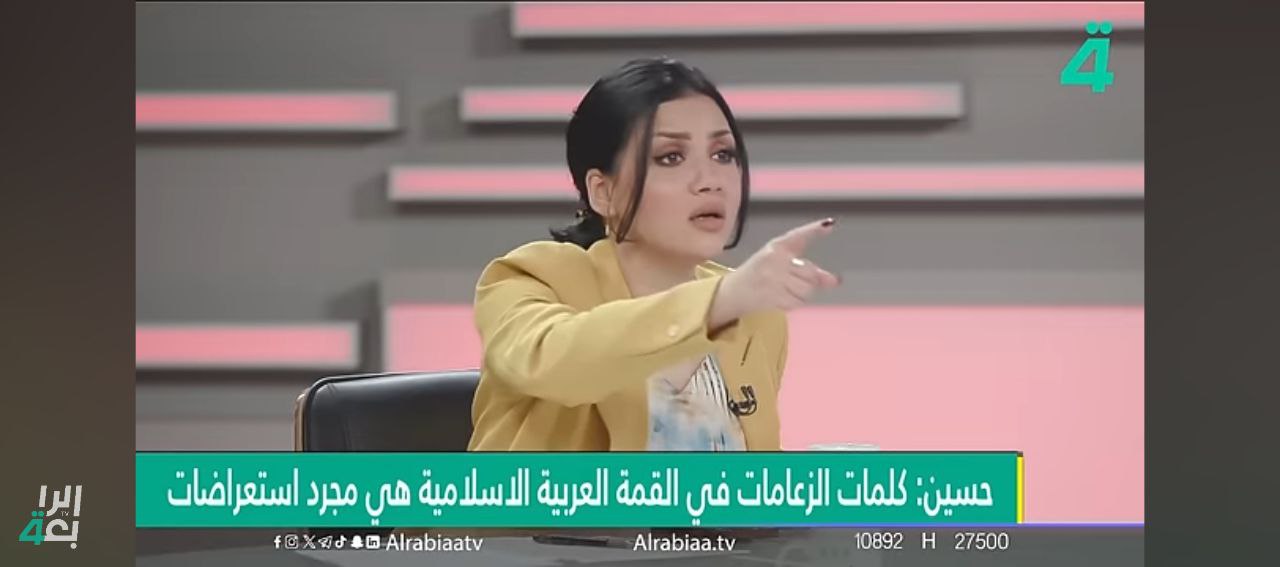
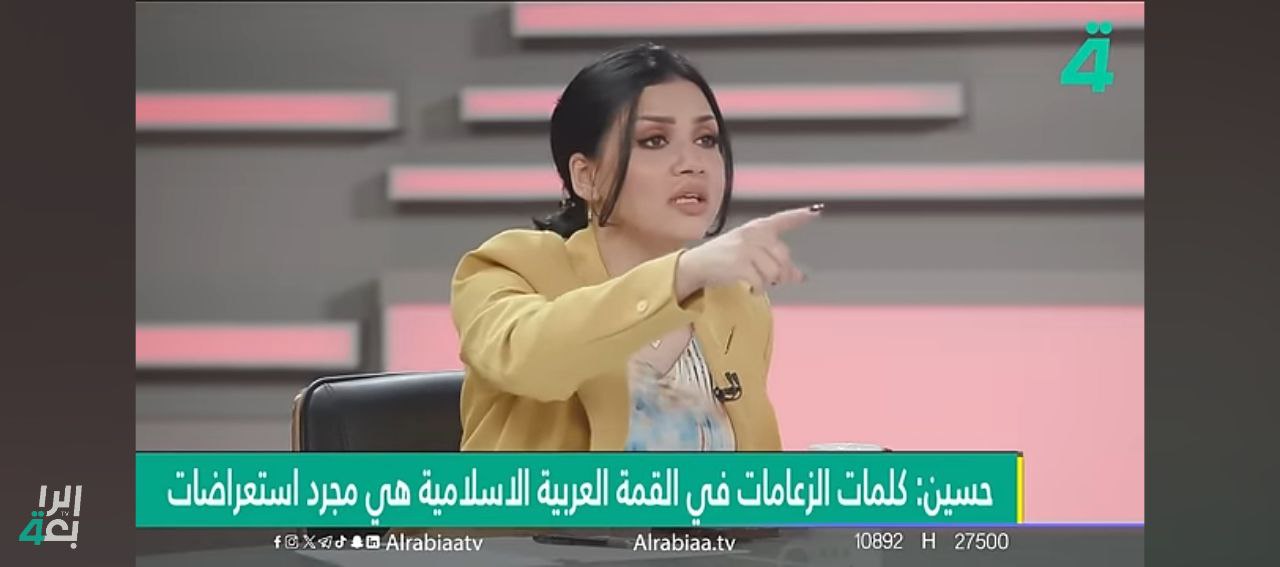
Forth Instance:’the Arab Gulf in general’ ‘الخليج العربي عموما’
In the episode under discussion,specificly when Muna speaks to her guest ‘Essam Hussein’ Muna utilizes a distinct gestural technique when discussing about Arabian Gulf,when she says ” So Saudi Arabia and the Gulf states in general are implementing American agendas” (Sami, 2024, 21:02). Opening her hands and bringing them together with a small gap between them. This action aims to create a circular shape, reminiscent of a ball or a planet, symbolizing the unity of the Gulf countries.
The specific type of gesture utilizes by Sami is known as an: iconic gesture’, which visually and tangibly represents a particular idea or concept. ‘Iconic gestures’are characterized by their ability to directly reflect the meaning being conveyed, thereby facilitating a clearer understanding for the audience. as it mentiones above, hands can be shaped to depict an object or illustrate a specific movement, making the abstract more concrete.
By employing this gesture, she seeks to convey to her audience that the Gulf nations function as a cohesive unit, collectively aligned in their decisions and policies. This visual representation not only reinforces her verbal message but also highlights the interconnectedness of these countries in regional matters. Such gestures are instrumental in academic discourse, as they enhance the clarity of complex ideas and foster a more profound understanding of the subject matter among the audience. Through this deliberate use of non-verbal communication, Muna effectively illustrates the solidarity and collaborative spirit that characterize the relationships among the Gulf states.
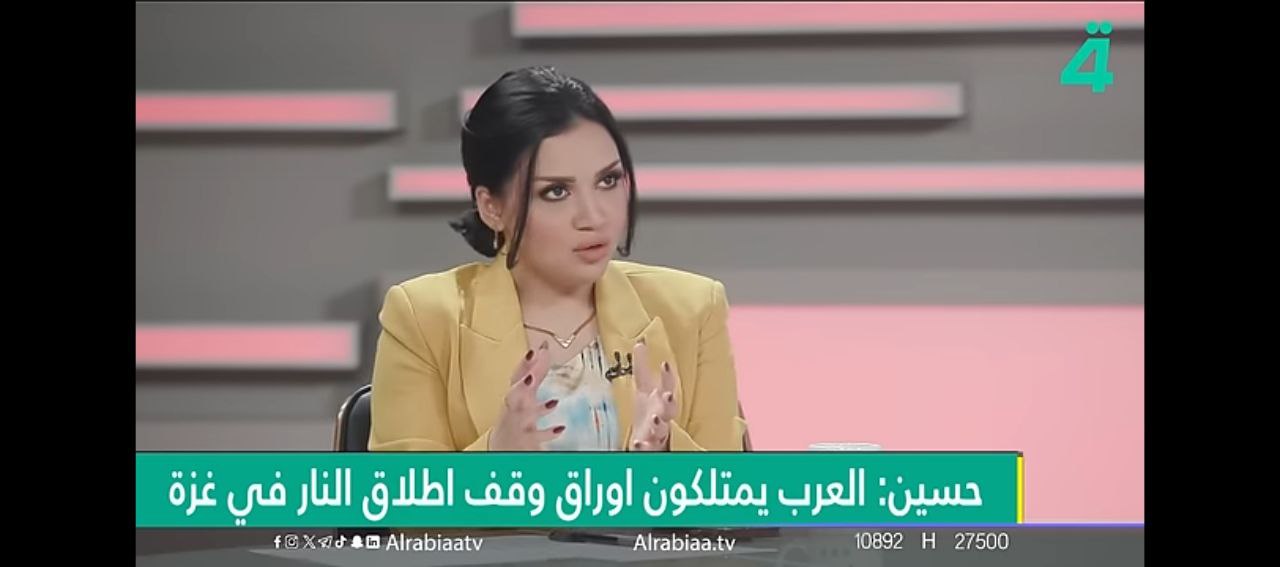
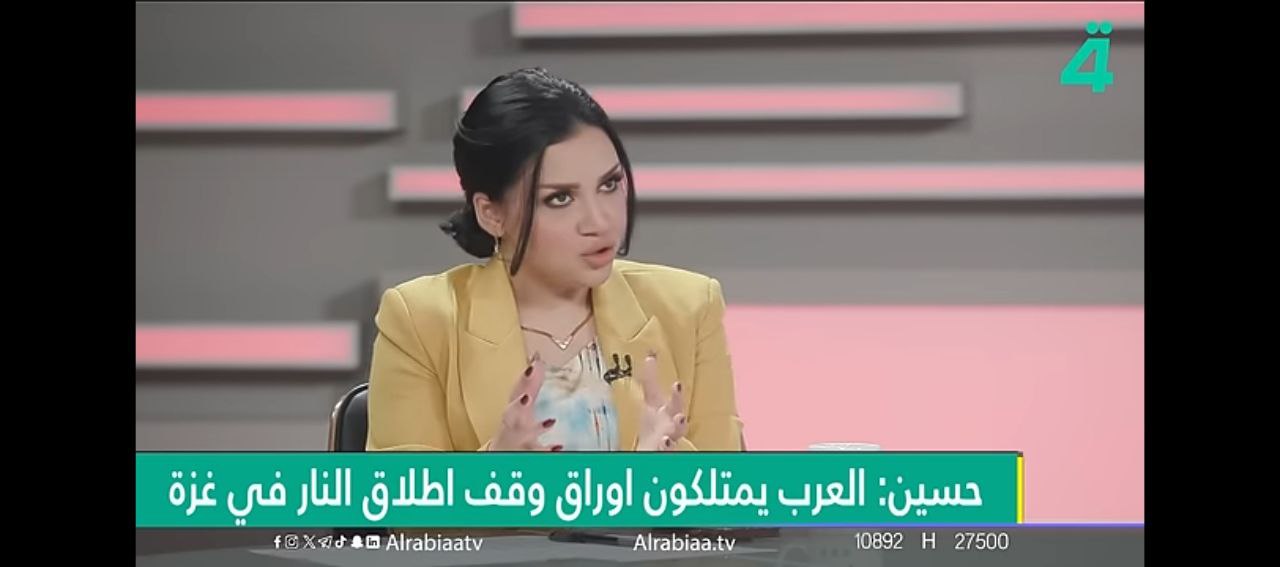
Fifth Instance:’as Mr. Essam said.’ ‘كما قال السيد عصام’
Through this episode, Muna’s hand movements further illustrate her engagement with the discussion, particularly when she raised her hand and extended her fingers towards the guest, Essam Hussein, who was seated directly in front of her, and she says” Saudi Arabia is really with demands to Israel and America wants to eliminate Hamas in any way, as Mr. Essam said” (Sami, 2024, 8:05). This gesture was complemented by her eye movement, which also focuses intently on Essam. Here Muna Sami employs a specific type of nonverbal communication know as ‘interactive gestures’. This strategic use of gestures serves to enhance focus and capture the attention of both the viewers and the guests. ‘Interactive gestures’ are crucial in social interactions as they not only encourage participation but also invite responses from others. These movements or signs are integral to effective communication, enhancing understanding and facilitating dialogue by clarifying meanings and emotions. In this context, Muna Sami skillfully utilizes her fingers and hands to point towards specific elements of the conversation, thereby directing attention to the contributions of Issam Hussein
By employing these coordinated gestures, Muna effectively highlights and redirects Essam’s speech to the attention of the other guests present. This non-verbal communication strategy not only emphasizes the significance of Essam’s words but also facilitates a more inclusive dialogue among all participants. Such deliberate gestures serve to enhance the clarity of communication in academic settings, fostering a collaborative atmosphere where ideas can be shared and discussed more effectively.
Through her adept use of these gestures, Muna Sami manages the dialogue with clarity and ease, ensuring that each guest had the opportunity to express their opinions freely while maintaining a structured flow of conversation. This illustrates her skill in facilitating meaningful discussions and underscores the significance of nonverbal cues in enhancing communicative effectiveness in a group setting.
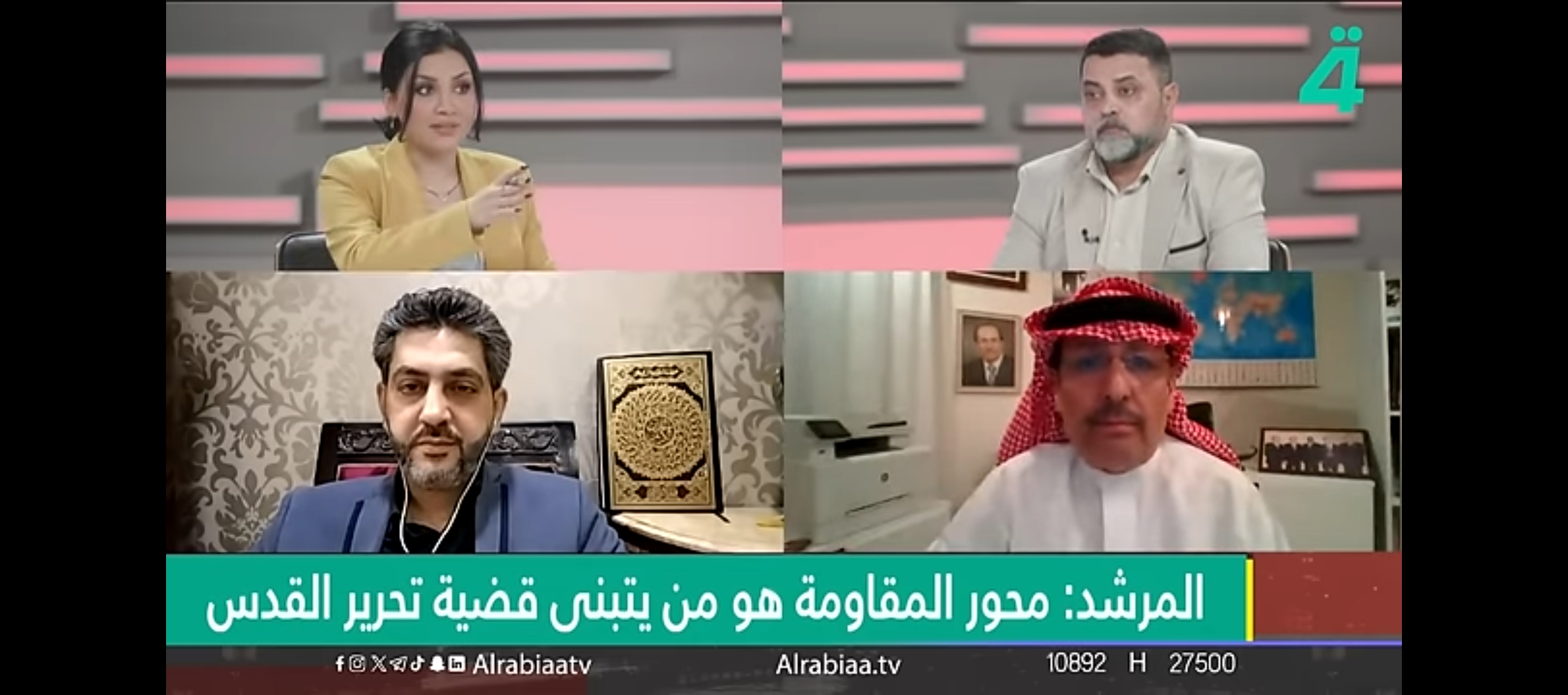
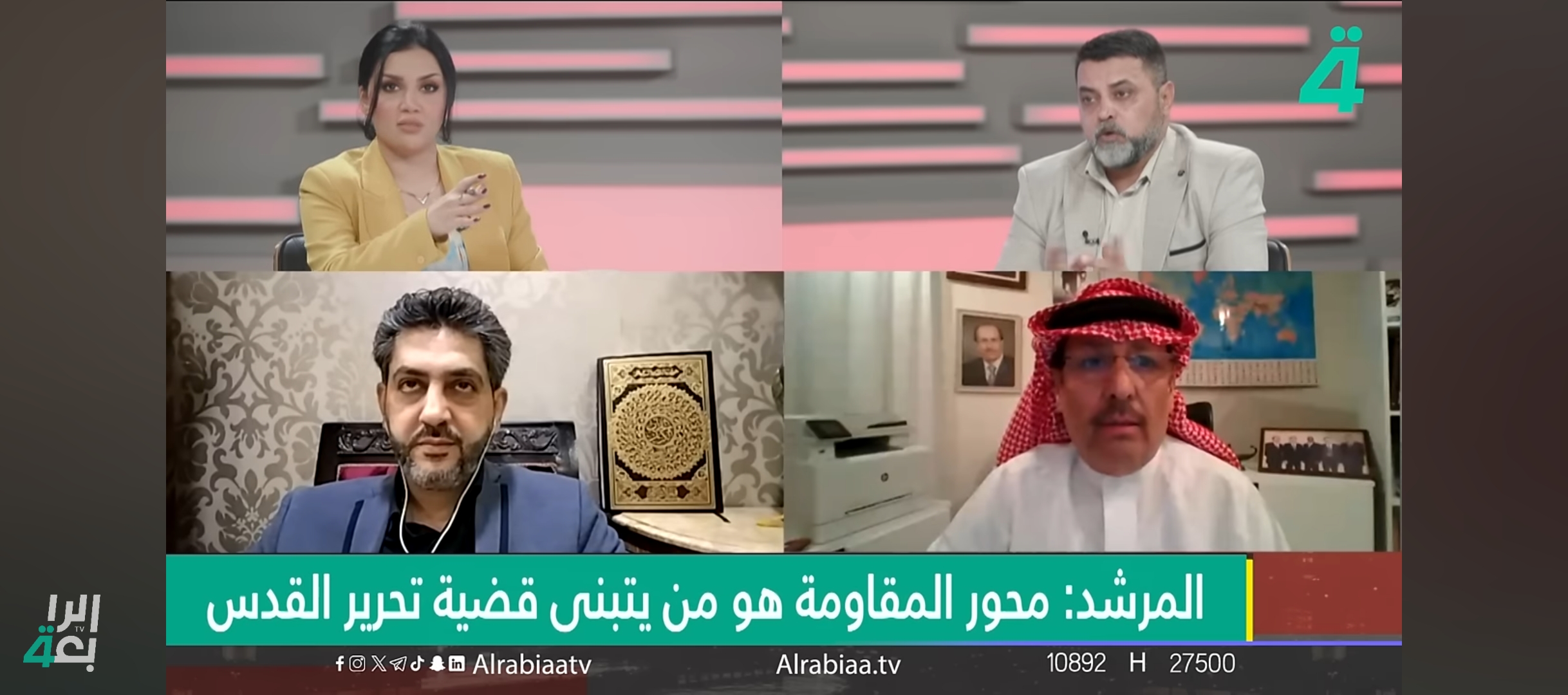
10. Conclusion
This study explores the role of gestures in communication, highlighting their ability to facilitate rapid idea exchange by bridging verbal and non-verbal cues that express a speaker’s thoughts and emotions. Focusing on Iraqi influencer Muna Sami, the analysis employs McNeill’s model to examine her strategic use of various gesture types and their impact on her communication style and effectiveness. Which the findings reveal that intentional gesture use significantly enhances audience engagement and message clarity in contemporary digital communication.
This study concludes that McNeill’s model of gesture types is applicable and observable in Iraqi media programs, particularly in the communication styles of Iraqi influencers. A detailed analysis of an episode featuring the media personality Muna Sami reveals her adept use of all five gesture types identified in McNeill’s framework: beats, iconic, deictic , interactive , and metaphoric gestures.
In the episode, Sami begins with beats, quick, short hand movements that serve to punctuate her speech and emphasize key points. Furthermore, she employs metaphoric gestures to illustrate abstract concepts by using her hands to indicate two related ideas simultaneously, effectively guiding the audience’s understanding of complex information. Additionally, the analysis identifies her use of deictic gestures, which direct the audience’s focus to specific objects or ideas, thereby reinforcing her verbal messages. Iconic gestures are also prevalent in her presentation, these gestures visually represent the content of her speech, making abstract ideas more tangible for her viewers. Interactive gestures play a crucial role in fostering engagement, as they invite audience participation and create a sense of connection between Sami and her viewers. Overall, this research elucidates how Iraqi influencers strategically utilize various types of gestures to convey both verbal and non_verbal messages. This study contributes to a deeper understanding of the role of non-verbal communication in media and its impact on influencer effectiveness.
References
Al-Rabia Channel. (2024, November 11). Riyadh Summit: A call for unity
to stop aggression on Lebanon and Gaza [Video].
Ariel, M. (2010). Defining pragmatics. Cambridge University Press.
Baum, E. B. (2004). What is thought? MIT Press.
Betti, M. J. (2021). Pragmatics in Linguistics.
Capone, N. C., & McGregor, K. K. (2004). Gesture development. Gesture.
Chare, N., & Watkins, L. (Eds.). (2017). Gesture and film: Signalling new
critical perspectives. Routledge.
Clark, H. H., & Murphy, G. L. (1982). Audience design in meaning and
reference. In Advances in psychology (Vol. 9, pp. 287-299). North-
Holland.
Crystal, D. (2002). Language death. Cambridge University Press.
Duffy, B. E. (2020). Social media influencers. The International
Encyclopedia of Gender, Media, and Communication, 1-4.
Dunmire, P. L. (2012). Political discourse analysis: Exploring the
language of politics and the politics of language. Language and
Linguistics Compass, 6(11), 735-751.
Ekman, P., & Friesen, W. V. (2003). Unmasking the face: A guide to
recognizing emotions from facial clues. Ishk.
Goldin-Meadow, S. (1999). The role of gesture in communication and
thinking. Trends in Cognitive Sciences, 3(11), 419-429.
Goldin-Meadow, S. (2015). From action to abstraction: Gesture as a
mechanism of change. Developmental Review, 38, 167-184.
Haviland, J. B. (2004). Gesture. A Companion to Linguistic Anthropology,
197(2003), 764-774.
Kelmaganbetova, A., Mazhitayeva, S., Ayazbayeva, B., Khamzina, G.,
Ramazanova, Z., Rahymberlina, S., & Kadyrov, Z. (2023). The role of
gestures in communication. Theory & Practice in Language Studies
(TPLS), 13(10).
Levinson, S. C. (1983). Pragmatics. Cambridge University Press.
Loukusa, S., & Moilanen, I. (2009). Pragmatic inference abilities in
individuals with Asperger syndrome or high-functioning autism: A
review. Research in Autism Spectrum Disorders, 3(4), 890-904.
McNeill, D. (2005). Gesture and thought. University of Chicago Press.
Slim, M. (2024, December 27). “من هي مني سامي ،السيرة الذاتية ويكيبيديا”
Ahlam Post. https://shorturl.at/YB2oF
Trotta, D., & Tonelli, S. (2021, June). Are gestures worth a thousand
words? An analysis of interviews in the political domain. In
Proceedings of the 1st Workshop on Multimodal Semantic
Representations (MMSR), 11-20.
Van Dijk, T. A. (1997). What is political discourse analysis? Belgian
Journal of Linguistics, 11(1), 11-52.
Whorf, B. L. (2012). Language, thought, and reality: Selected writings of
Benjamin Lee Whorf. MIT Press.
Yule, G. (1996). Pragmatics. Oxford University Press.
Yule, G. (2022). The study of language. Cambridge University Press.
